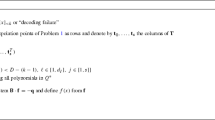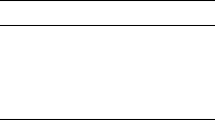Abstract
A syndrome decoding algorithm for lifted interleaved Gabidulin codes of order L is proposed. The algorithm corrects L times more deviations (packet insertions) than known syndrome decoding methods with probability at least \(1-8q^{-n}\), where n is the length of the (interleaved) Gabidulin code. For \(n<L\), the proposed scheme has L times less computational complexity than known interpolation-factorization based decoders which attain the same decoding region. Upper bounds on the decoding failure probability are derived. Up to our knowledge this is the first syndrome-based scheme for interleaved subspace codes that can correct deviations beyond the unique decoding radius.

Similar content being viewed by others
Notes
In case the error locators \(X_0,\dots ,X_{\tau -1}\) are known and the error values are unknown, (23) does not form a linear system of equations in the unknown error-values \(b^{(j)}_0,\dots ,b^{(j)}_{\tau -1}\).
References
Ahlswede R., Cai N., Li S., Yeung R.: Network information flow. IEEE Trans. Inf. Theory 46(4), 1204–1216 (2000).
Bartz H.: Algebraic decoding of subspace and rank-metric codes. PhD thesis, Technische Universität München (2017)
Bartz H., Meier M., Sidorenko V.: Improved syndrome decoding of interleaved subspace codes. In: 11th International ITG Conference on Systems, Communication and Coding 2017 (SCC), Hamburg, Germany (2017).
Bartz H., Wachter-Zeh A.: Efficient decoding of interleaved subspace and Gabidulin codes beyond their unique decoding radius using Gröbner bases. Adv Math Commun. 12(4), 773–804 (2018). https://doi.org/10.3934/amc.2018046.
Gabidulin E.M.: Theory of codes with maximum rank distance. Probl. Inf. Transm. 21(1), 3–16 (1985).
Gabidulin E.M., Paramonov A.V., Tretjakov O.V.: Rank errors and rank erasures correction. In: International Colloquium Coding Theory (1991).
Gabidulin E.M., Pilipchuk N.I.: A new method of erasure correction by rank codes. In: IEEE International Symposium of Information Theory (ISIT), p. 423 (2003).
Gabidulin E.M., Pilipchuk N.I.: Error and erasure correcting algorithms for rank codes. Des. Codes Cryptogr. 49(1–3), 105–122 (2008).
Gadouleau M., Yan Z.: Complexity of decoding Gabidulin codes. In: 42nd Annual Conference on Information Sciences and Systems (CISS), pp. 1081–1085 (2008). https://doi.org/10.1109/CISS.2008.4558679.
Guruswami V., Xing C.: List decoding Reed-Solomon, algebraic-geometric, and Gabidulin subcodes up to the singleton bound. Electron. Colloq. Comput. Complex. 19, 146 (2012).
Horn R.A., Johnson C.R.: Matrix Analysis. Cambridge University Press, Cambridge (2012).
Kötter R., Kschischang F.R.: Coding for errors and erasures in random network coding. IEEE Trans. Inf. Theory 54(8), 3579–3591 (2008). https://doi.org/10.1109/TIT.2008.926449.
Li W., Sidorenko V., Silva D.: On transform-domain error and erasure correction by Gabidulin codes. Des. Codes Cryptogr. 73, 571–586 (2014).
Lidl R., Niederreiter H.: Finite Fields. Encyclopedia of Mathematics and Its Applications. Cambridge University Press, Cambridge (1996).
Loidreau P., Overbeck R.: Decoding rank errors beyond the error correcting capability. In: International Workshop Algebraic and Combinatorial Coding Theory (ACCT), pp. 186–190 (2006).
Overbeck R.: Decoding interleaved Gabidulin codes and ciphertext-security for GPT variants (preprint).
Overbeck R.: Public key cryptography based on coding theory. PhD thesis, TU Darmstadt, Darmstadt, Germany (2007).
Richter G., Plass S.: Error and erasure decoding of rank-codes with a modified Berlekamp-Massey algorithm. In: ITG Conference on Source Channel Coding (SCC) (2004).
Sidorenko V.R., Jiang L., Bossert M.: Skew-feedback shift-register synthesis and decoding interleaved Gabidulin codes. IEEE Trans. Inf. Theory 57(2), 621–632 (2011).
Sidorenko V.R., Richter G., Bossert M.: Linearized shift-register synthesis. IEEE Trans. Inf. Theory 57(9), 6025–6032 (2011). https://doi.org/10.1109/TIT.2011.2162173.
Silva D.: Error control for network coding. PhD thesis, University of Toronto, Toronto, Canada (2009).
Silva D., Kschischang F.R., Kötter R.: A rank-metric approach to error control in random network coding. IEEE Trans. Inf. Theory 54(9), 3951–3967 (2008).
Skachek V., Roth R.M.: Probabilistic algorithm for finding roots of linearized polynomials. Des. Codes Cryptogr. 46(1), 17–23 (2008).
Wachter-Zeh A., Zeh A.: Interpolation-based decoding of interleaved Gabidulin codes. In: International Workshop on Coding and Cryptography (WCC) (2013).
Wachter-Zeh A., Zeh A.: List and unique error-erasure decoding of interleaved Gabidulin codes with interpolation techniques. Des. Codes Cryptogr. 73(2), 547–570 (2014). https://doi.org/10.1007/s10623-014-9953-5.
Acknowledgements
The authors would like to thank Manuela Meier for developing the simulation framework for the improved syndrome decoder.
Author information
Authors and Affiliations
Corresponding author
Additional information
Publisher's Note
Springer Nature remains neutral with regard to jurisdictional claims in published maps and institutional affiliations.
V. Sidorenko is on leave from Institute for Information Transmission Problems, Russian Academy of Sciences. His work is supported by the Russian Government (Contract No. 14.W03.31.0019).
This is one of several papers published in Designs, Codes and Cryptography comprising the “Special Issue on Coding and Cryptography”.
Appendix
Appendix
1.1 Proof of Lemma 1
Proof
Let us first consider
for all \(j=1,\dots ,L\). Define the vectors
and
for all \(\ell \in [0,D]\). The equality in (62) follows from the definition of the q-reverse (see (4)). Defining
we can write (59) as
We now show that the rank of \(\mathbf {Z}\) in (64) is full, i.e. \({{\mathrm{rk}}}_{q^m}(\mathbf {Z})=L\). The matrix
contains the coefficients of \(\varGamma ^{(1)},\dots ,\varGamma ^{(L)}\) as columns. Since \(\varGamma ^{(1)},\dots ,\varGamma ^{(L)}\) are \(\mathbb F_{q^m}\)-linearly independent, we have \({{\mathrm{rk}}}_{q^m}(\tilde{\mathbf {Z}})=L\). Thus, using elementary column operations, we can transform \(\tilde{\mathbf {Z}}\) into a matrix that contains \(L\) unit row vectors. These unit rows are invariant under the row-wise Frobenius automorphisms applied in (64) and thus we have \({{\mathrm{rk}}}_{q^m}(\mathbf {Z})=L\). Hence, the mapping
is bijective. The Frobenius powers \(\overline{\varGamma }_{l}^{(j)}\left( x^{[d-2]}\right) ^{[-(d-2)]}\) in (43) correspond to raising each coefficient of \(\overline{\varGamma }_{l}^{(j)}(x)\) to the \([-(d-1)]\) which does not affect the rank of \(\mathbf {Z}\) in (64). Since \(\varLambda _\text {U}(x)\) is nonzero and common for all modified syndromes it follows that the mapping \(\left( s^{(1)}(x) \ s^{(2)}(x) \ \dots \ s^{(L)}(x)\right) \mapsto \left( \tilde{s}^{(1)}_\text {UD}(x) \ \tilde{s}^{(1)}_\text {UD}(x) \ \dots \ \tilde{s}^{(L)}_\text {UD}(x)\right) \) is bijective. \(\square \)
Rights and permissions
About this article
Cite this article
Bartz, H., Sidorenko, V. Improved syndrome decoding of lifted \(L\)-interleaved Gabidulin codes. Des. Codes Cryptogr. 87, 547–567 (2019). https://doi.org/10.1007/s10623-018-0563-5
Received:
Revised:
Accepted:
Published:
Issue Date:
DOI: https://doi.org/10.1007/s10623-018-0563-5
Keywords
- Subspace codes
- Rank-metric codes
- Interleaved Gabidulin codes
- Probabilistic unique decoding
- Syndrome-based decoding




